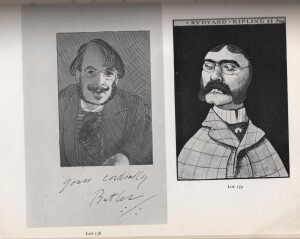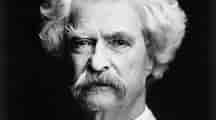
Some writers knowingly produced erotica; others unknowingly published smutty material. Here are a few examples
Conscious
Pietro Aretino (1492 – 1556), Sonnetti Lussuriosi(1524)
The Sonnetti Lussuriosiof this poet, gossip and writer of witty plays was a collection of verses and erotic drawings that, like the Kama Sutra, demonstrated positions for sexual intercourse. Though the book proved very popular, it earned the wrath of the Pope, an erstwhile patron of Aretino, along with Emperor Charles V. Aretino lost his papal patronage, but he also was taken to task by the Dean of St Paul’s Cathedral, Dr John Donne, who objected that some of the sexual positions were missing.
Norman Douglas (1868 – 1952), Some Limericks(1928)
The author of Old Calabria and South Wind, also compiled Venus in the Kitchen, a collection of aphrodisiac recipes, and the privately printed Some Limericks. The latter, which has been described as ‘ irreverent, scatological and erotic ‘ , was accompanied by ‘ scholarly ‘ notes that sent up the sort of po-faced critical apparatus so beloved of Ph D candidates.
W S. Gilbert ( 1836-1911) and Arthur Sullivan ( 1842 – 1900) . ‘ The Sod’s Opera’.
The humorous double act that gave us so many wonderful operettas also composed The Sod’s Opera , among the characters of which are Count Tostoff and the Brothers Bollox ( a pair of hangers on) and Scrotum, a wrinkled old retainer. Oddly, there are no records of a public performance, though it would be refreshing if some village Opera society put on their version of it.
Anais Nin ( 1903 -77 ) The Delta of Venus.
The friend of pornographer Henry Miller got together with Nin and an army of hard up writers to form a sort of porn factory which turned out several erotic works, some commissioned by an anonymous tycoon. Ms Nin was also a novelist and a prolific diarist.
Felix Salten aka Siegmund Salzmann ( 1869 – 1949) Josefine Mutzenbacher.
The apparently wholesome author of Bambi(1929), a children’s story which recounted the struggle of an orphaned deer, which was later immortalized by Walt Disney, also penned an extremely well received erotic novel that painted a very accurate picture of the life of a prostitute among the petit bourgeoisie in fin de siecleVienna. Today it is regarded as equal in status in the German-speaking word to our own Fanny Hill. Continue reading

 Even today, thirty six years after his death, John Betjeman can still surprise us with his wisdom and original mind. In 1947, less than two years after the end of a war that brought the prospect of a radiation death to the innocent citizens of Great Britain, destroyed some of finest Georgian terraces in London and Bath, that peppered landmark buildings, including St Paul’s Cathedral and the Dulwich Art Gallery with shrapnel, and pock-marked the pastoral landscapes of Surrey, Middlesex and Essex, the editors at Methuen asked the rising poet of the suburbs to provide an Introduction to their new anthology by someone called J. D. Mortimer ( who he?) on the Home Counties.
Even today, thirty six years after his death, John Betjeman can still surprise us with his wisdom and original mind. In 1947, less than two years after the end of a war that brought the prospect of a radiation death to the innocent citizens of Great Britain, destroyed some of finest Georgian terraces in London and Bath, that peppered landmark buildings, including St Paul’s Cathedral and the Dulwich Art Gallery with shrapnel, and pock-marked the pastoral landscapes of Surrey, Middlesex and Essex, the editors at Methuen asked the rising poet of the suburbs to provide an Introduction to their new anthology by someone called J. D. Mortimer ( who he?) on the Home Counties.
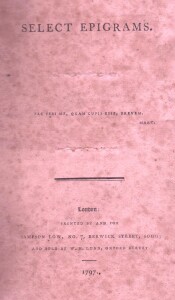
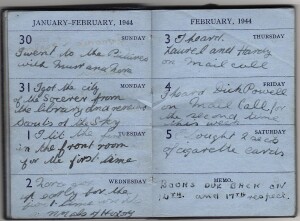

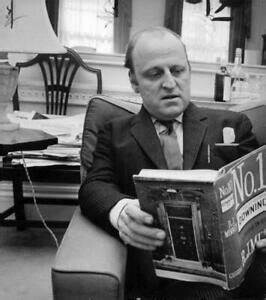

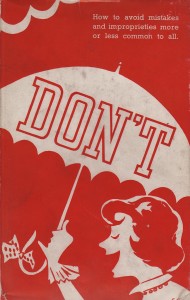
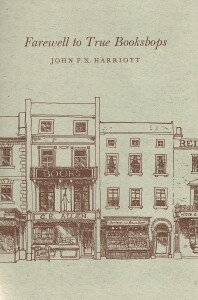
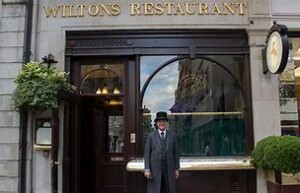
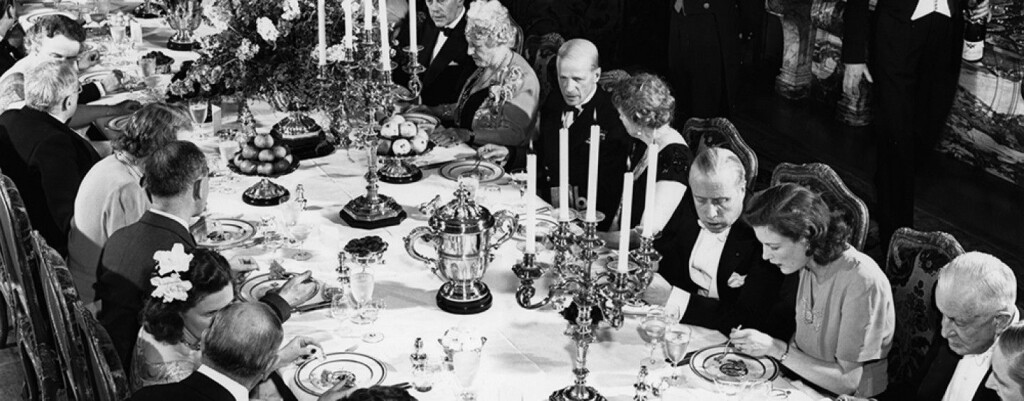
 Advances
Advances If you search for ‘Paul Lester’ online most the results will concern Paul Lester, the prolific rock critic and biographer; but anyone interested in performance poetry over the past 45 years will hopefully ignore these references and refine their search by adding ‘ poet ‘ or ‘Birmingham’ to ‘ Paul Lester’. They could also add ‘Protean ‘. For ever since Lester published his first poetry pamphlet in 1975 he has been regularly issuing slim volumes ( some very slim) , usually under his own imprint, Protean Publications, from an address in Knowle, near Solihull, although he actually lives in Rubery, in the far south-west edge of Birmingham.
If you search for ‘Paul Lester’ online most the results will concern Paul Lester, the prolific rock critic and biographer; but anyone interested in performance poetry over the past 45 years will hopefully ignore these references and refine their search by adding ‘ poet ‘ or ‘Birmingham’ to ‘ Paul Lester’. They could also add ‘Protean ‘. For ever since Lester published his first poetry pamphlet in 1975 he has been regularly issuing slim volumes ( some very slim) , usually under his own imprint, Protean Publications, from an address in Knowle, near Solihull, although he actually lives in Rubery, in the far south-west edge of Birmingham.
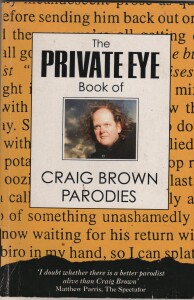 Around 2002 I was interviewing celebs on their book collection for Book and Magazine Collector while also researching the life of acclaimed poet and critic Geoffrey Grigson. One day I read an interview with the famous parodist Craig Brown, whose brilliant contributions to Private Eye had always had me in stitches. Judging from the interview, Brown’s library was dominated by biographies and especially memoirs of living figures in all fields, but with an emphasis on show biz. Interviewing him, I felt, would be a change from talking to rather dour politicians and academics on their first editions. And so it turned out.
Around 2002 I was interviewing celebs on their book collection for Book and Magazine Collector while also researching the life of acclaimed poet and critic Geoffrey Grigson. One day I read an interview with the famous parodist Craig Brown, whose brilliant contributions to Private Eye had always had me in stitches. Judging from the interview, Brown’s library was dominated by biographies and especially memoirs of living figures in all fields, but with an emphasis on show biz. Interviewing him, I felt, would be a change from talking to rather dour politicians and academics on their first editions. And so it turned out.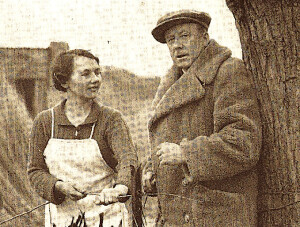
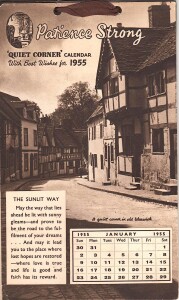 Found amongst a pile of books at Jot HQ, the pocket-sized ‘Patience Strong ‘Quiet Corner ‘calendar for 1955 with its sepia photographs of ‘ picturesque ‘ spots in England. We had almost forgotten that publishers still used sepia photographs as late as this, but then remembered the lifeless and dispiriting photographs of landscapes and empty streets in Arthur Mee’s ‘King’s England’ series of county guide books. No wonder the county guides published by Shell from 1934 were regarded as such a welcome change from these dreary volumes. Mee’s totally predictable descriptions of towns and villages in each county were matched by Strong’s trite and cliché-ridden verse formatted as prose in her calendar and exemplified in ‘ The Sunlit Way ‘which accompanied a traffic-free photo of a ‘ quiet corner of old Warwick ‘ on the page for January 1955.
Found amongst a pile of books at Jot HQ, the pocket-sized ‘Patience Strong ‘Quiet Corner ‘calendar for 1955 with its sepia photographs of ‘ picturesque ‘ spots in England. We had almost forgotten that publishers still used sepia photographs as late as this, but then remembered the lifeless and dispiriting photographs of landscapes and empty streets in Arthur Mee’s ‘King’s England’ series of county guide books. No wonder the county guides published by Shell from 1934 were regarded as such a welcome change from these dreary volumes. Mee’s totally predictable descriptions of towns and villages in each county were matched by Strong’s trite and cliché-ridden verse formatted as prose in her calendar and exemplified in ‘ The Sunlit Way ‘which accompanied a traffic-free photo of a ‘ quiet corner of old Warwick ‘ on the page for January 1955.
